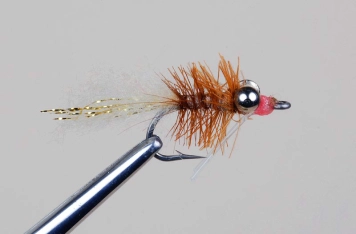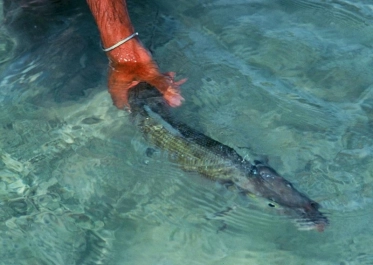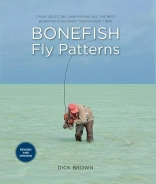Omeko Glinton created the Meko Special in an attempt to come up with a single fly that you can fish over any color bottom so you don’t have to waste time changing flies as you move from flat to flat.
An Omeko Glinton design. Sample in photo was tied by Orvis production tiers on a size 4 34007 hook and measures horizontally 19⁄16" in length from beginning of hook eye to end of tail; clipped hackle body is 1⁄2" in diameter. Fly rides hook-point up with metal eyes; hook-point down with plastic eyes.
Tying notes:
The tail should be about one and one-quarter to one and one-half times the length of the hook shank. Omeko originally tied the pattern with bead-chain eyes for 11⁄2- to 2-foot depths, but later he and Orvis began using lead eyes for deeper water
and very small bead-chain or plastic eyes for tailing. You can also weed-proof it with 15 lb. mono spikes for grassy bottoms.
Location notes:
Especially effective on Grand Bahama and most other Bahamas locations; also fished well in Los Roques, Belize, and the Florida Keys. Omeko says he created the Meko Special in an attempt to come up with a single fly that you can fish over any color bottom so you don’t have to waste time changing flies as you move from flat to flat. Thus he chose neutral colors, which look natural by blending in with both dark and light bottoms.
Fishing notes:
Meko says he likes to strip his fly so it moves like a shrimp. He uses a 10- to 12-inch strip every second until the fish sees it, then stops the fly and waits for the fish to charge and take it. If the fish are really eager, just keep stripping as they come onto the fly and strip-strike as they reach and take it.
Prey notes:
While Omeko chose neutral colors to suggest generic resident shrimps that blend with any color flat, he wound, or “palmered,” hackle on the body to suggest moving parts like swimming legs, claws, and antennae because he had seen the way soft wound hackle gave life to flies for other species.
Anecdotes:
Omeko was still experimenting with this fly—trying different colors and hackle—when he found out he would be guiding Orvis CEO Perk Perkins, who had arrived to fish at the Deep Water Cay Club armed with his company’s latest bonefish patterns. The fishing was hard and they were getting a lot of refusals, so Omeko told Perk about his new fly and asked if he wanted to try throwing it as nothing else was working. Perk agreed, and Meko said the first fish they threw it to sucked it up like he hadn’t eaten for a week. Then another fish took it. And then another. “What’s the name of that fly?” Perk asked. Omeko had been so busy tying different versions, he hadn’t even thought of naming it yet, so he said—almost as a joke—“the Meko Special.” A week later, after Perk had returned to the States, Omeko received a contract allowing Orvis to be the exclusive distributor of the Meko Special and providing Omeko with royalties for the pattern, enabling the fly to become a worldwide flats favorite.
Omeko Glinton
is a fourteen-year veteran flats guide at Deep Water Cay Club who started guiding right after graduating from school. He received his initial training from the staff at DWCC but, like so many good Bahamian guides, his skills seem to run in his family. His grandfather David Pinder not only helped build DWCC in the mid-1900s, but he also became one of its most successful longstanding guides, and his father, Stanley Glinton, is head guide at North Riding Point Club, where his uncle Leroy also guides. A successful tournament competitor, Omeko placed first in the annual Bahamas National Bonefish Championship in 2002 and second in the World Invitational Bonefish Tournament in 2001.
You can read the review here, buy the book here and read much more about Dick Brown on his own web site.
Reprinted from Bonefish Fly Patterns, 2nd Edition by Dick Brown, © 2011.
Published by Lyons Press, an imprint of Globe Pequot Press, Guilford, CT.
- Log in to post comments













